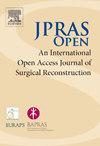用于预防接受放疗的乳腺癌患者急性放射性皮炎的异种富血小板血浆洗剂:一项开放标签随机对照试验。
IF 1.5
Q3 SURGERY
引用次数: 0
摘要
背景:乳腺癌患者在放射治疗(RT)期间会出现急性放射性皮炎(ARD)。本研究探讨了新开发的异种富血小板血浆洗剂(PRP)对乳腺癌患者ARD的预防作用。方法:本研究纳入保乳术后导管原位癌及早期浸润性乳腺癌患者。采用低分割全乳放射治疗(42.5 Gy,共16份),然后进行肿瘤床强化治疗(10 Gy,共5份)。患者被随机分配到XONRID®凝胶(n = 48)或PRP洗剂(n = 52)组。我们在放疗期间和放疗后2周每周记录皮肤毒性,由两位资深放射肿瘤学家根据RTOG定义对ARD进行评分,并由患者主观评分疼痛数值评定量表(NRS)和皮肤生活质量指数(DLQI)。结果:XONRID®凝胶组3例(6%)患者出现3-4级ARD, PRP洗剂组无一例(p < 0.001)。XONRID凝胶组中有1例患者由于无法忍受的疼痛而未完成RT,并拒绝完成每周问卷调查和随访。与XONRID®凝胶组相比,PRP洗剂组显著降低和延缓了平均ARD的进展(p = 0.001),降低了疼痛值的平均NRS (p = 0.021)和平均DLQI (p = 0.048)。结论:这项随机对照试验首次使用异种PRP洗剂预防ARD。这种洗剂对ARD有预防作用,从而提高了接受RT的患者的生活质量。本文章由计算机程序翻译,如有差异,请以英文原文为准。
Xenogeneic platelet-rich plasma lotion for preventing acute radiation dermatitis in patients with breast cancer undergoing radiotherapy: An open-label, randomized controlled trial
Background
Breast cancer patients experience acute radiation dermatitis (ARD) during radiation therapy (RT). This study investigated the prophylactic effect of a newly developed xenogeneic platelet-rich plasma (PRP) lotion on ARD for breast cancer patients.
Methods
This study enrolled patients with ductal carcinoma in situ and early-stage invasive breast cancers after breast-conserving surgery. Hypofractionated whole-breast RT (42.5 Gy in 16 fractions) followed by tumour bed boost (10 Gy in 5 fractions) was used. The patients were randomly assigned to XONRID® gel (n = 48) or PRP lotion (n = 52) groups. We recorded the skin toxicity weekly during RT and at 2 weeks after RT. ARD was graded on the basis of the RTOG definition by two senior radiation oncologists, and the numerical rating scale (NRS) for pain and Dermatology Life Quality Index (DLQI) were subjectively scored by patients.
Results
Grade 3–4 ARD was noted in three (6 %) patients in the XONRID® gel group and no patients in the PRP lotion group (p < 0.001). One patient did not complete RT in the XONRID® gel group due to intolerable pain and refused to complete the weekly questionnaires and follow-ups. Compared with the XONRID® gel group, the PRP lotion group had significantly reduced and delayed progression of mean ARD (p = 0.001), lower mean NRS for pain value (p = 0.021) and lower mean DLQI (p = 0.048).
Conclusions
This randomized controlled trial is the first to use xenogeneic PRP lotion for ARD prevention. This lotion has prophylactic effects against ARD and thus improves quality of life of patients undergoing RT.
求助全文
通过发布文献求助,成功后即可免费获取论文全文。
去求助
来源期刊

JPRAS Open
Medicine-Surgery
CiteScore
1.60
自引率
0.00%
发文量
89
审稿时长
22 weeks
期刊介绍:
JPRAS Open is an international, open access journal dedicated to publishing case reports, short communications, and full-length articles. JPRAS Open will provide the most current source of information and references in plastic, reconstructive & aesthetic surgery. The Journal is based on the continued need to improve surgical care by providing highlights in general reconstructive surgery; cleft lip, palate and craniofacial surgery; head and neck surgery; skin cancer; breast surgery; hand surgery; lower limb trauma; burns; and aesthetic surgery. The Journal will provide authors with fast publication times.
 求助内容:
求助内容: 应助结果提醒方式:
应助结果提醒方式:


